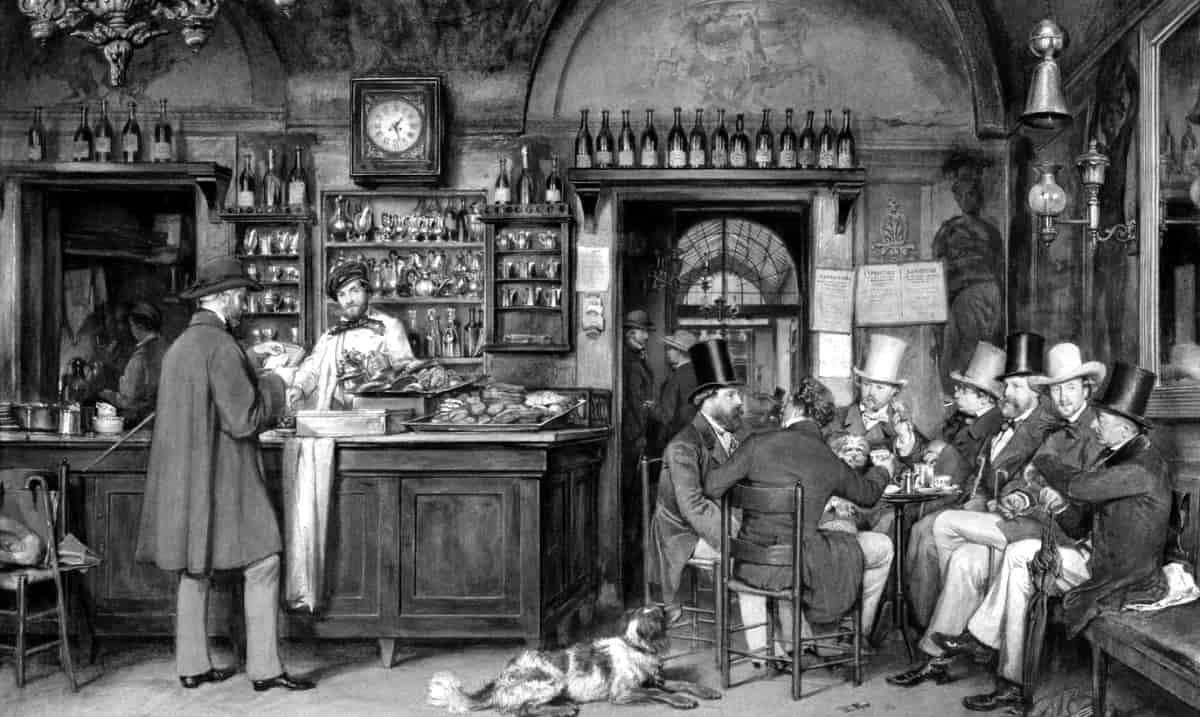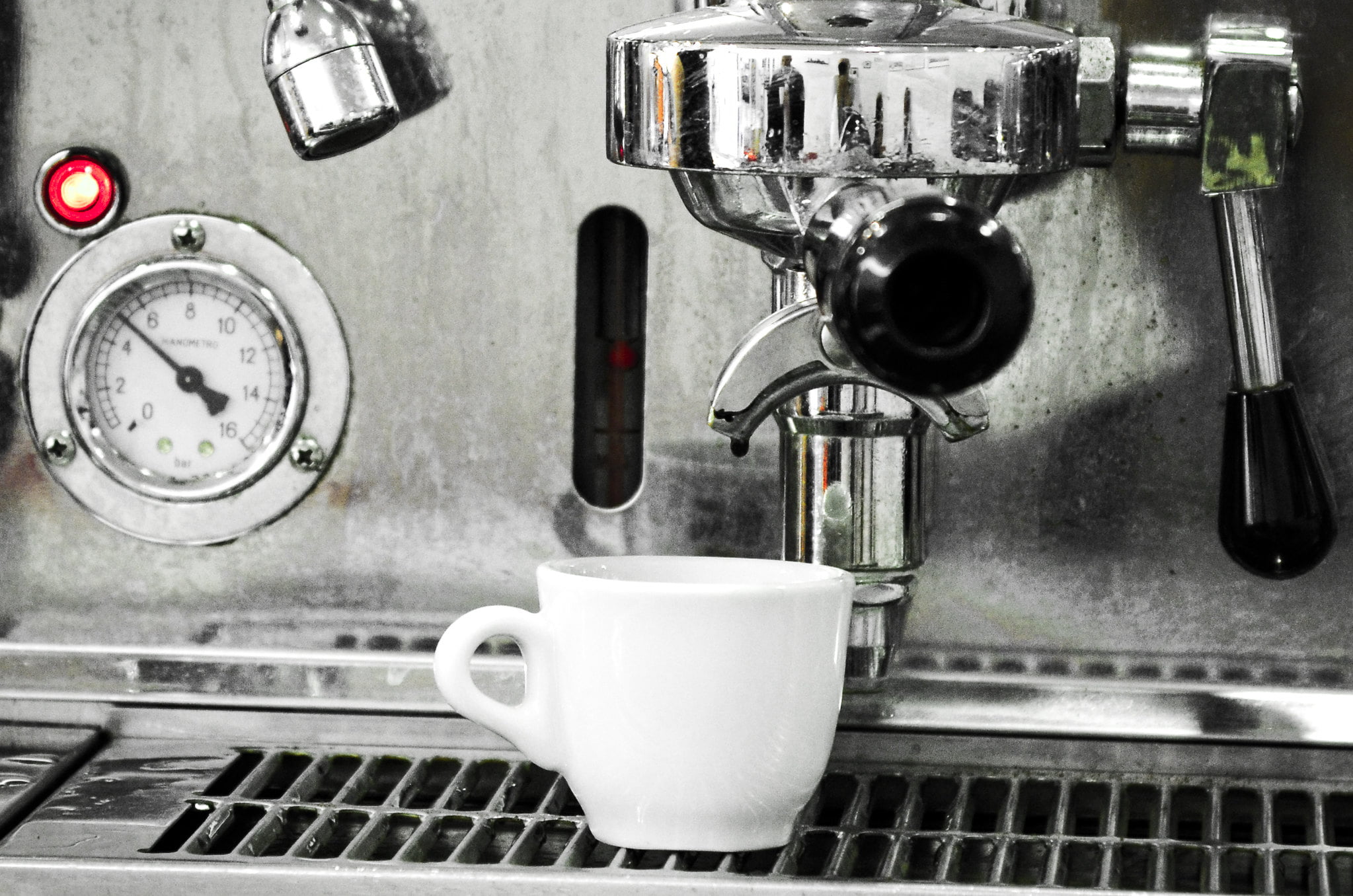The coffee experience goes far beyond just taste; it’s a multi sensory journey that engages all of our senses. From the moment you smell the freshly ground beans to the sound of coffee brewing and the feeling of a warm cup in your hands. Enjoying coffee is a symphony of sensory delights.
Waking up to the smell of coffee means family — means memory, identity and hospitality. A coffee prepared at home: is an indispensable pleasure, an encouragement, a cuddle, a gesture of love and sharing – a sensory journey of coffee culture beyond taste.
In this Article
MEMORY of coffee: A symphony of sensory delights.
For years, and every morning, the Moka pot has been spreading the scent of coffee in the Italian kitchens and homes. Her hum opening the day and gloriously closing the meals, is so singularly pleasant that the writer Frances Yates called it
the most beautiful music since Mozart.
A sensory journey of domestic coffee culture
The Italian verb “sentire” – to hear – is maybe most accurately translated into English as “to sense”, in practice it relates to most of our human senses and is used with extreme frequency and ease in everyday Italian. According to the context, it can mean to feel, to see, to hear, to smell or to taste: there is simply no single equivalent in English with the capacity to encapsulate such a broad range of human sensations.
Multisensory experience – is maybe indicative of the meaning of coffee and coffee culture in Italy, it is perceived by all our senses.

The ear knows — SOUND
Italian life centers around coffee. Whether it’s the slow awakening with a “a tazzulella ‘e cafè”, a little cup of Neapolitan coffee from the cuccumella (Neapolitan Flip brewer) or the sound of a Bailetti stove top coffee maker percolating after lunch, coffee unites Italians of all ages and walks of life. 98% of Italians drink it – daily and often in company.
The popping sounds emitted by coffee beans during the roasting process are music for some, “telling” them the right grade of roast. Near the end of the roasting process, these sounds are known as “first crack” and “second crack.”
The melodic, rhythmic sounds of roasting, grinding, tamping, and each machine’s own natural melody can be relaxing in a ritualistic way.

The sound of the word coffee
Coffee is one of the world’s most commonly used words, infused with slight semantic variations according to each language and culture (café, kaffee, kopi, kaapi, caffé, kafei, kohi, etc.).
The word and pronunciation were slightly adapted to better suit local languages and their natural acoustic.
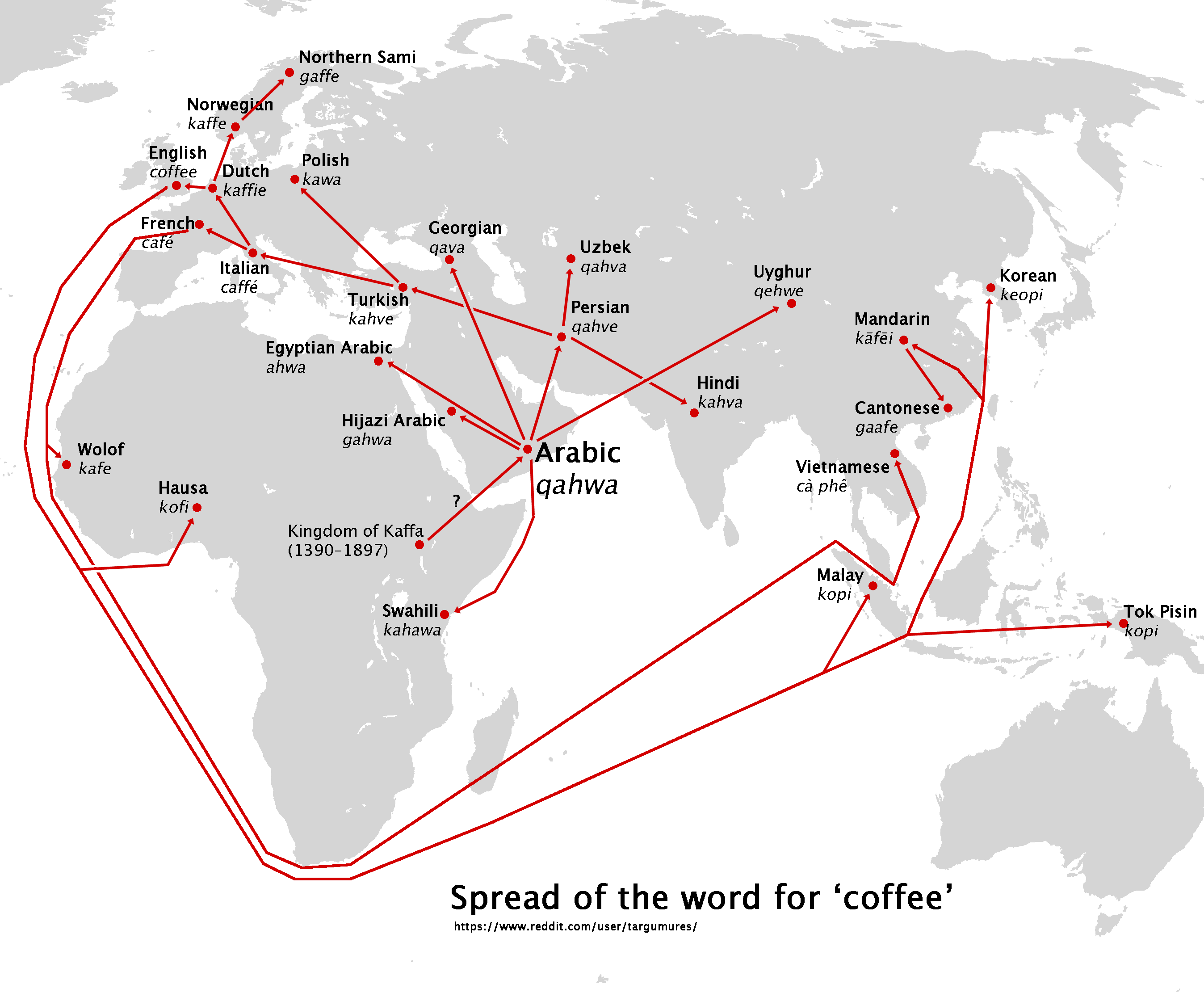
The etymology of the word: coffee derives from the Arabic qahwah (exciting), which later became kahve in Turkey, the land from which it then arrived in Europe.
The lush-leaved trees and their precious berries, which range from green to bright red when mature – originate in East Africa, most likely Ethiopia, where the Kaffa Kingdom may have baptized the plant with its name – قهوه qahwah.
This etymology has been disputed, though, since the Oromo people of Ethiopia refer to the coffee berries as bun.
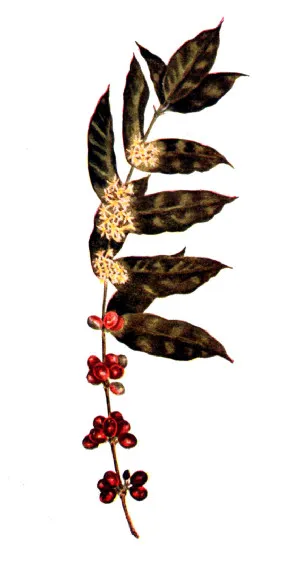
Instead, many argue that the Kaffa province was named for the beans. Other possible derivations for qahwah include quwwa (the Arabic word for “power”), and kafta, the drink made from the khat plant (Pendergrast 2010).
Another etymology suggests that coffee comes from Arabic, meaning “dark color,” – originally used for strong wine that was made from the pulp and husks of coffee beans.
Some languages use different words to emphasize their socio-cultural relationship with coffee. Like the Italian language.
Caffé pronounced as kaf-feh, is coffee, not café, as in the place you’d go to get a coffee, but that’s not what we call coffee shops. Italians go to a bar to get an espresso. Espresso is about speed and is traditionally drunken outside the home.

At home we use the Moka, the Napoletana and nowadays semi-professional espresso machines, home espresso makers with pods or capsule and fancy coffee brewing devices. Coffee is traditionally served in a tazzina ta-ZZ-EE-naa, a tiny moka or espresso cup.
Just holding a warm cup of coffee provides many with a sense of comfort – especially when cradling porcelain or glass.
Rituals of everyday life
My grandma was our grand coffee master preparing la macchinetta, – literal for small machine – I observe, with sleepy eyes, how her wrinkled hands treat the coffee pot with care and love. Preparing it the way her mum did. Turning on the fire and soon after the scent of coffee wafting through the house. It is still inducing a sense of warmth and comfort in Italian homes, making us feel at ease. I grew up with it.
The scent of coffee is the scent of home-brewed memories and emotions, a fragrance, both evocative and personal.
Alessandro Gusman writes in his, Antropologia dell’olfatto, Anthropology of smell:
“Daily olfactory practices, can be thought of as rituals of everyday life. From this point of view it is possible to recognize «olfactory rhythms», which mark the life of men and structure their time; these rhythms include holidays as moments of interruption of the normal flow of existence…”
Religious or pagan, holidays and olfactory rhythms and rites of everyday life; the smell of coffee in the morning in an Italian home is confirmation of this.
Alessandro Gusman
Having un caffè is a daily ritual in Italy, the day cannot begin without having had the first coffee at breakfast, followed by that in the mid-break morning, after lunch, in the afternoon, and sometimes after dinner, as if to mark the various Times of Day.
Coffee has become popular as a local and global beverage in part because people see coffee as “our own.” It becomes meaningful for many reasons, which include the attachments or fondness that we develop for the ways that coffee is prepared and served, the places or contexts in which we consume coffee, and the ideas and feelings associated with drinking it.
More of the world’s coffee is consumed in homes than in any other place, thus coffee has become part of the comforts of family life for many adults.
Catherine M Tucker, Coffee Culture: Local Experiences, Global Connections.
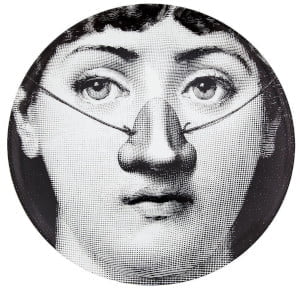
The nose knows — SCENT
Smell is one of the most powerful senses, as it sends signals directly to our brain. Not only does our sense of smell give us a better understanding of the world around us, but it also has the power to alert us to danger, shift our moods and bring back memories. Drinking coffee boosts mood, memory, and psycho motor performance, well, sniffing it, can deliver similar brain-boosting benefits, including greater attention span, increased alertness and strengthened memory. Of course, the caffeine is what helps our organism to wake up in the morning.
The active ingredient in coffee, isolated for the first time in 1820, a substance emblematic of the modern individual’s striving for hyper productivity and appetite for hyper stimulation.
Jeffrey T. Schnapp
Several scientific studies have demonstrated that the scent of coffee alone is strong enough to stimulate our cognitive function. Even a quick whiff of coffee might make us feel ready to conquer the day ahead.
Coffee chemistry
Our ability to smell is called olfaction, and the smell – or aroma – of coffee is a key component of its flavor profile. Aroma in coffee takes the form of gaseous chemical components that are released into the air in large quantities when coffee is freshly ground, and then as vapor when it is brewed. And again when we swallow it, the coffee vapor rises upward from inside our mouth to reach our olfactory receptors.
The water-soluble taste and aromatic compounds of coffee are perceived primarily through smell (the olfactory membranes) and taste buds (nerve endings on the tongue and in the lining of the mouth).
Coffee Aroma
The olfactory sense has two facets: aroma and flavor. Aroma, or odor, is the olfactory sensation created by breathing. Strong aromas are present in roasted whole beans and freshly ground coffee, but the prepared beverage itself doesn’t release many volatile compounds.
Coffee Chemistry is not yet fully decoded, understanding how over 800 coffee elements interact with the olfactory epithelium and the brain. According to science, coffee is one of the most appetizing smells to humans. The unique aroma of coffee hits all the attractive scents including sweet, spicy, fruity, floral, and smoky. Specifically each scent has its own molecule. Phenols create the bitterness found in coffee, but they also generate the smoky or earthy smell often found in dark roast coffee. Another molecule, Furfurylthiol, is known to be associated with “coffee smell” by itself according to certain studies. Additionally, Mercapto is a “spicy” scent commonly associated with curries and is even found in some human sweat. Lastly, Hydroxymethylfurfural (HMF) is responsible for the caramel or sweet smell that attracts most people to drink coffee. More molecules and aromatic compounds are listed here.
None of this compounds can be identified as the predominant flavor of coffee.
Coffee Flavor
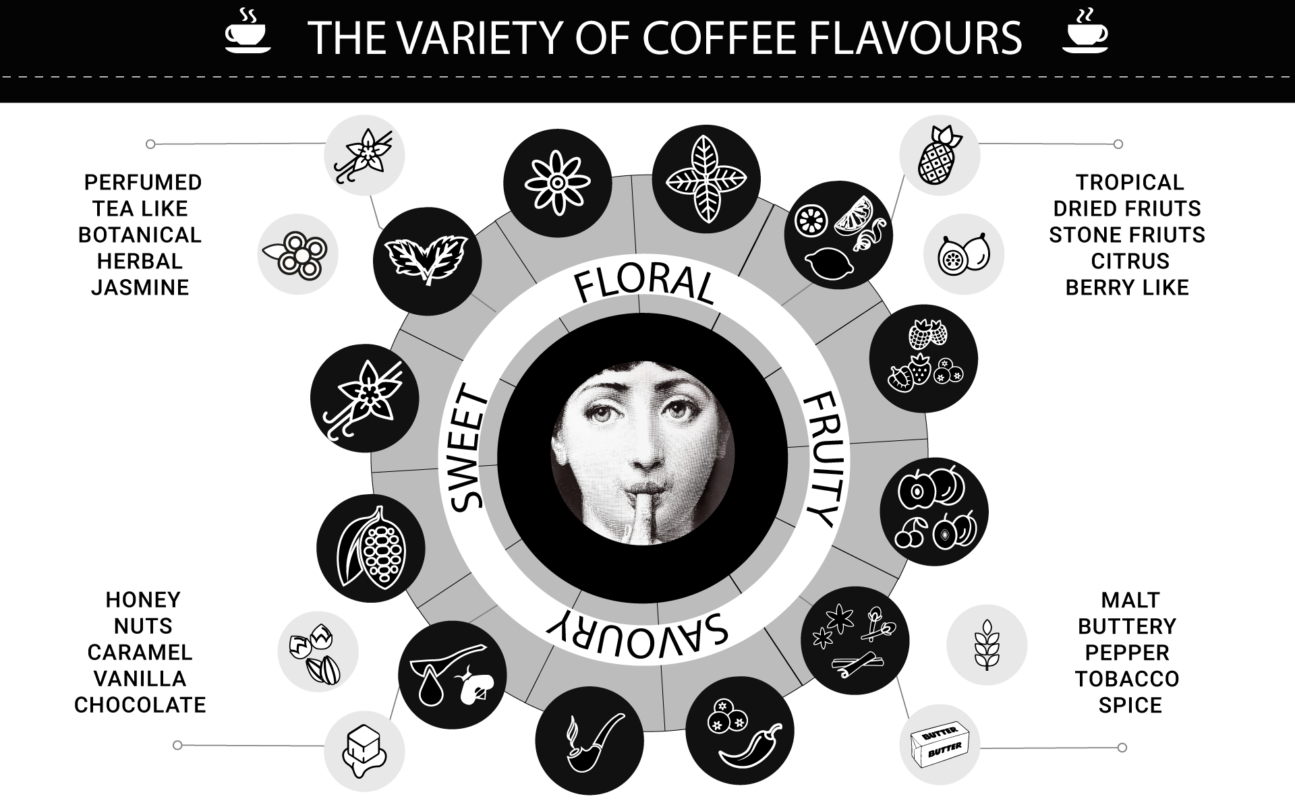
Coffee cuppers (professional coffee tasters) often distinguish the coffee’s taste from its aroma, acidity, sweetness/bitterness, aftertaste/finish and overall aromatic profile, including its body. Coffee cuppers are trained to describe the tastes and aromas of brewed coffee and evaluate a coffee bean’s quality and profile. Coffee cupping is both an art and a science, requiring extensive training, a refined palate, and a passion for coffee.
With hundreds of compounds, each with their unique flavor, evaluating the finished brew is the job of professionals that practice sensory skills. They define tasting notes written on menus or on bags of beans. What they’re really giving is their best assessment of the multitude of flavor notes in the coffee. Because we all perceive flavors differently – due to experience level, personal bias, genetics, heritage – it’s understandable that we perceive a coffee differently than it has been described to us. However, most people would agree if the coffee is very sweet or very bitter.
To smell the things we eat and drink enhances our ability to taste them. Our sense of smell is responsible for about 80% of what we taste. Indeed, we detect the underlying flavor of something – whether it’s a cup of coffee or the coffee grind – with our noses rather than our mouths. Without a sense of smell, coffee wouldn’t taste nearly as nuanced.
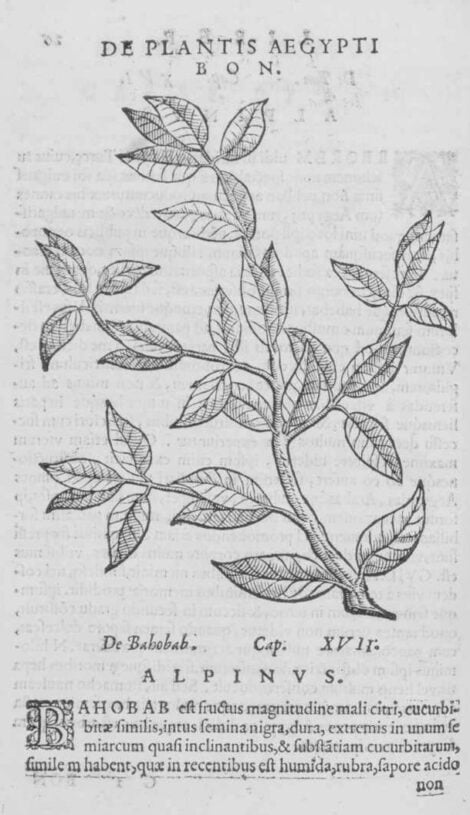
Coffee – Ichor
Coffee – Ichor, this word of my creation describes exactly what the scent of coffee is for me – the sublime smell of coffee born of the ethereal liquid flowing in the veins of the Greek gods – making them immortal (ἰχώρ ikhṓr).
There is no evidence, that the ancient Greeks and Romans gods and mortals, had the pleasure of tasting coffee, but they would have adored it – I, descend from people who lived in what is now Italy during the Greek and Roman era, and do like coffee, with all my senses.
It’s possible that coffee and rice came to what is now South Italy, during its Byzantine era. Italy was also a major center of the Renaissance and that is the time, when glorious coffee culture started in Italy.
Coffee was introduced in Europe in the 16th Century when its use was reported by a number of travelers from the East.
These included a Venetian named Prospero Alpino (1553-1617), a botanist and doctor, whose book De Plantis Aegypti, “Book of Egyptian Plants”, contains an illustration of the coffee plant. In this volume he describes, for the first time in Italy, the plant called “Bon” and the custom of imbibing a dark energy-giving drink, obtained by boiling its berries: coffee.

The mouth knows — TASTE
And then, the moment of truth—the pouring of the coffee into the warm tazzina (the demitasse espresso cup). The complex symphony of aromas intensifies, with each note revealing a layer of the coffee’s character.
The steam rising from the cup carries with it a medley of scents—nutty, chocolaty, fruity, or floral—each one a reflection of the beans’ origin, roast, and preparation.
Coffee gustation
The process known as gustation is how we taste coffee through our taste buds. When we taste, we simultaneously detect four basic tastes: acidity, bitterness, sweetness, saltiness and sourness sweet (umami). A loanword from Japanese (うま味), umami can be translated as “pleasant savory taste”. You can find this brothy or meaty taste in foods that contain a high level of the amino acid glutamate, like Parmesan cheese, seaweed, miso, and mushrooms.
These tastes will all be present in coffee, each to a greater or lesser extent, and they also have the ability to interact with one another through taste modulation. For instance, a taste that features a salt component can reduce the perception of bitterness and increase the perception of sweetness. When we say acidity in coffee, what we mean for tasting is the brightness, and the dry sensation that brings out the flavor profile of the coffee, or on the negative side, the sourness or pungency of a cup.
Mouthfeel, the body of coffee
The inside of our mouth, including our tongue, gums and hard and soft palate, contain nerve endings that allow us to detect oiliness and viscosity in coffee, or what we refer to as mouthfeel, or body.
All coffee also contains some amount of lipids, including fat, oil and wax. This is the perceived oiliness of coffee. The lipids are extracted when we brew coffee, but unlike many other chemical components, they do not dissolve into the brew. They can often be seen as an oily residue that sits on the surface of a cup of coffee.
Viscosity is the perception of solid material that is present in the finished brew. This can be microscopic bean particles that have made its way through the filter. The brewing method does impact body and the amount of sediments: metal, mesh and loose filters allow more particles through than tight, thick paper filters.
Aftertaste
The finish, also called aftertaste is the flavor that lingers after you’ve drank the coffee. Some coffee will have a short or sharp finish where once you drink it, those flavors in your mouth disappear almost instantly. In Italy we generally enjoy coffee that lingers a little while.
The brewing ritual, be it a hurried morning routine or a cherished moment of contemplation, is a sensory experience like no other.
The aroma filling the room is like the epilogue of the family gathering – it’s evocative of childhood memories.
In Italian culture, the kinship between food and word is attested by language and its tasty metaphors: thus we ‘thirst’ for knowledge, ‘hunger’ for knowledge or information, we ‘digest’ some concepts with difficulty, ‘we devour’ a book, we ‘drink’ a story they tell us, we make ‘sour’ jokes, we whisper ‘sweet’ words, we tell ‘spicy’ stories, we ‘assimilate’ certain ideas, we ‘chew’ a little Indonesian, and again, we ‘we eat words’ or we ‘drink our brains’.
“Mangiarsi le parole – Eating your words” (not to pronounce clearly, or breaking a promise) and “parlare come si mangia – speak the way you eat, don’t try to impress me!” In short, expressions that starting from the similarity between the food of the body and the food of the mind, underline the link between eating, drinking and talking (thinking), showing how much human culture is reflected in the words that come out of the mouth and in the wisely ingested foods. The mouth remains, on a symbolic level, the place where food becomes culturally accepted.
Food ways, like language, are a communication code capable of transmitting various meanings, (economic, social, political, religious, ethnic, aesthetic, etc.) becoming a sign of distinction and identification, a socio-cultural identity marker. Multiculturalism happens whenever different socio-cultural groups find themselves in close proximity, interacting in the same relational spaces.
Coffee is an acquired taste. It is no accident that Mennell Stephen, chose to illustrate his fundamental assertion in, “All Manners of Food”, that “in humans most likes and dislikes are learned” by citing the psychologist Robert C. Bolles” idea that:
“Coffee is one of the great, marvelous flavors. Who could deny that? Well,actually anyone drinking coffee for the first time would deny it.
Coffee is one of those things that [have been] called innately aversive. It is bitter and characterless; it simply tastes bad the first time you encounter it. By the time you have drunk a few thousand cups of it, you cannot live without it.
Children do not like it, uninitiated adults do not like it, rats do not like it; nobody likes coffee except those who have drunk a fair amount of it, and they all love it.”
That initiation into coffee inevitably takes place within the context of family, so that our taste in coffee is, in reality, a taste for coffee as it is blended, roasted, prepared and served within that community.
Consequently coffee can become a sensory evocation of one’s membership of a social grouping – simply a shared taste.
It is in many ways an excellent exemplar of the type of “banal nationalism” identified by Michael Billig, as essential for the reproduction of “established nations”. Coffee has become an iconic symbol of the nation in Italy.
The “Italian espresso” has become closely identified with the country by both Italians and foreigners alike as have other coffee based beverages (cappuccino, macchiato etc) and food which employ it. For me the first coffee taste came in the form of ice cream, coffee-infused gelato – with the name coppa del nonno (grandpa’s cup) and as the creamy Tiramisù.
Tiramisù
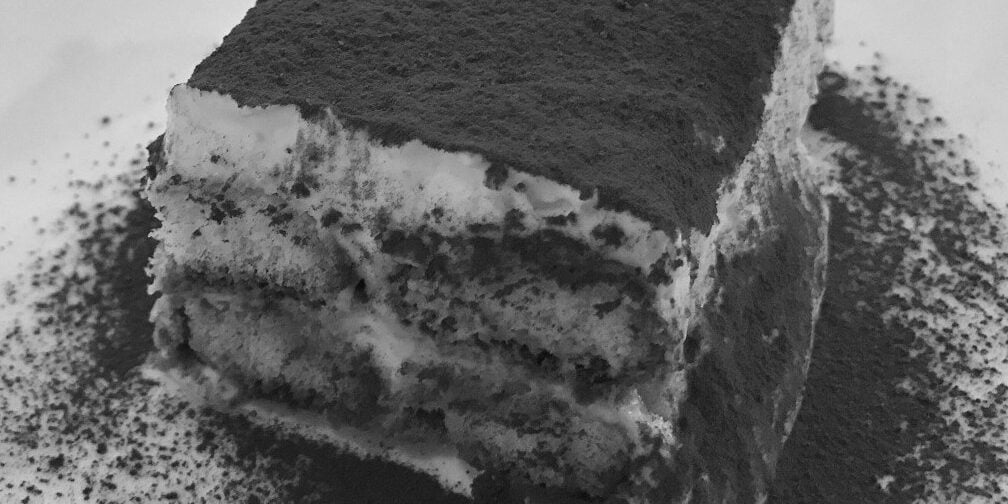
The word Tiramisù literally means “pick-me-up”, in local dialects of north- eastern Italy.
According to the Accademia del Tiramisù, an organization devoted to transmitting the culture of tiramisù, the name is due to alleged aphrodisiac effects. Giovanni Comisso stated that the dessert was born in the 1930s in a brothel located in the center of Treviso, where it was served to guests to refresh, or pick-them-up. Whether or not this tale has even the lightest cocoa dusting of truth to it, food historians debate two other origin stories from Treviso and Udine, both cities, having a distance of 1 hr 21 min, or 116.2 km:
The first comes from the Veneto region of Italy where it was called “Tireme su ”, Italianized into Tiramisù. The dessert was created in the 1970s by Chef Linguanotto in the restaurant Le Beccherie (https://www.lebeccherie.it/allegati/ricetta-storia-tiramisu-en.pdf) in Treviso.
The other origin story comes from the nearby Friuli Venezia Giulia region in the town of Udine. There is written evidence of the first document recipe from 1959 – though it was been noted that earlier recipes used butter and whipped cream in place of mascarpone. This “Tìrimi Su” originated from a hotel restaurant in Tolmezzo called Roma. Because of the handwritten recipe of Norma Pielli, cook and owner with her husband Beppe of the Albergo Roma, the Ministry of Agriculture and Food Resources named Tiramisù as a Friulian dish in 2017.
The original Tiramisù recipe from Norma Pielli

Here is the original recipe from Norma Pielli, which uses savoiardi biscuits, mascarpone, eggs, coffee, cocoa powder and sugar. The two warring regions agree on these six ingredients, although the richer Le Beccherie version uses egg yolks alone, beaten into sweetened mascarpone, while the lighter, frothier Albergo Roma dish folds whipped whites into the mascarpone as well.
4 whole eggs,
300 gr. of white sugar,
500 gr. of mascarpone,
40/45 ladyfingers, sponge fingers or boudoir biscuits,
300 cc. of bitter and strong coffee left to cool,
100 gr. of dusting of bitter cocoa.
A pinch of salt
Make a good coffee (moka or espresso), set aside and let cool in a bowl. Whip 3 egg whites and the whole egg with a pinch of salt until stiff. In another bowl whip 3 yolks with the sugar, then fold mascarpone into the mixture, to create a soft cream. Finally carefully fold the whipped egg whites into the cream.
Dip the savoiardi into the coffee, being careful not to soak them. Drain them, lightly squeezing the excess liquid out with a fork. Arrange them in a line, on the flat bottom of a terrine or baking dish. Spread half of the cream over the savoiardi. Repeat using remaining savoiardi to create a second layer on top of the first. Spread the remaining cream on top. Let it rest in the refrigerator for 12 hours. Dust the dessert with bitter cocoa powder using a strainer before serving.
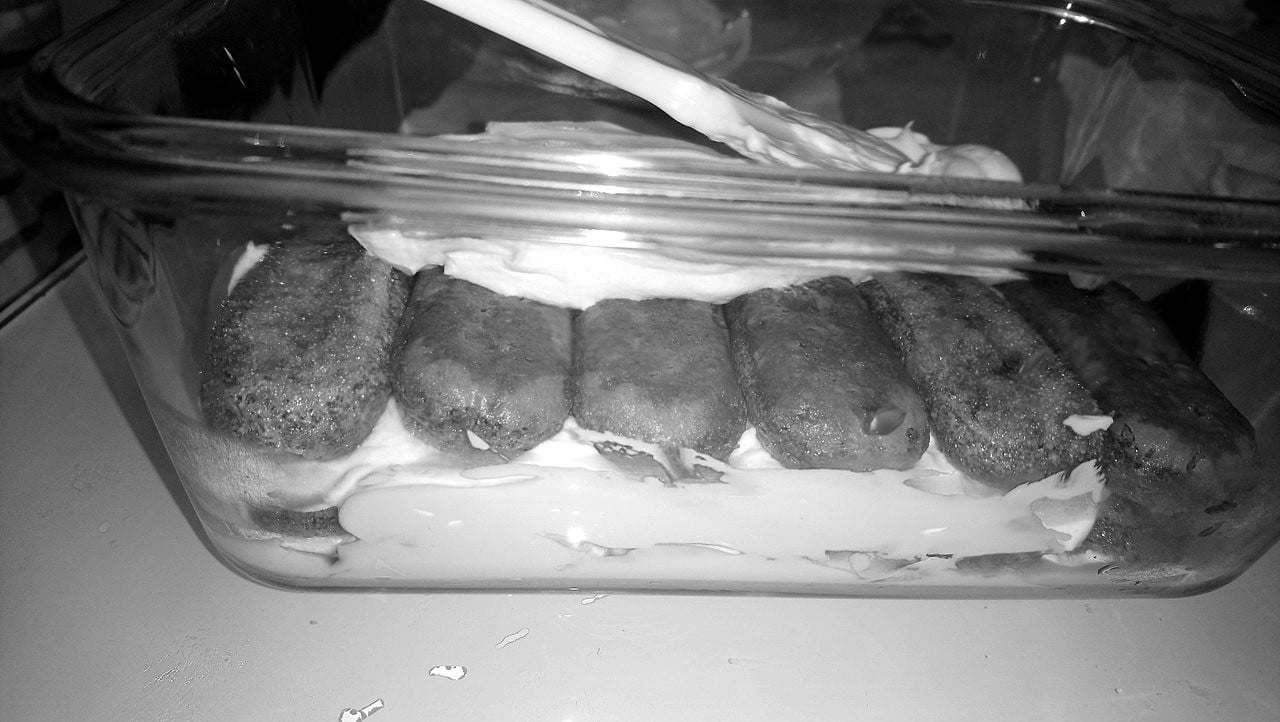
My grandma would add a shot or three of Zabov, a light egg liqueur with only 15°, to the rich, velvety mascarpone cream, my mother Coffee liqueur and my grandaunt would add Marsala, fortified wine from Sicily.
Le Beccheries recipe would not add alcohol, as the dish once was served to pregnant women and nursing mothers, to build up their strength. There might be some truth in it, it is a truly nourishing dessert and very heavy to digest. Almost a full meal, but convivial family gatherings take so many hours and coffee’s, post-meal cigarettes and alcohol, that at the end you’re feeling hungry again.

The heart knows — FEELINGS
La dolce vita
That is, what we call la dolce vita, an expression used to describe the sweet life; full of beauty, pleasures, and entertaining events – a life of love, food and celebrating the art of being together. In Italy, family gatherings are frequent, like saint’s days and festivals, centered around food and the extended networks of families.
Also tensions exist among close relatives or affines, for various reasons, and family gatherings are occasions for the exasperation of such tensions too. Dramas are frequent in this occasions. Commensality can be poisoned by conflict and betrayal. The man who had betrayed the mafia bandit Salvatore Giuliano was killed a few years ago in the Ucciardone jail of Palermo with a poisoned cup of coffee..
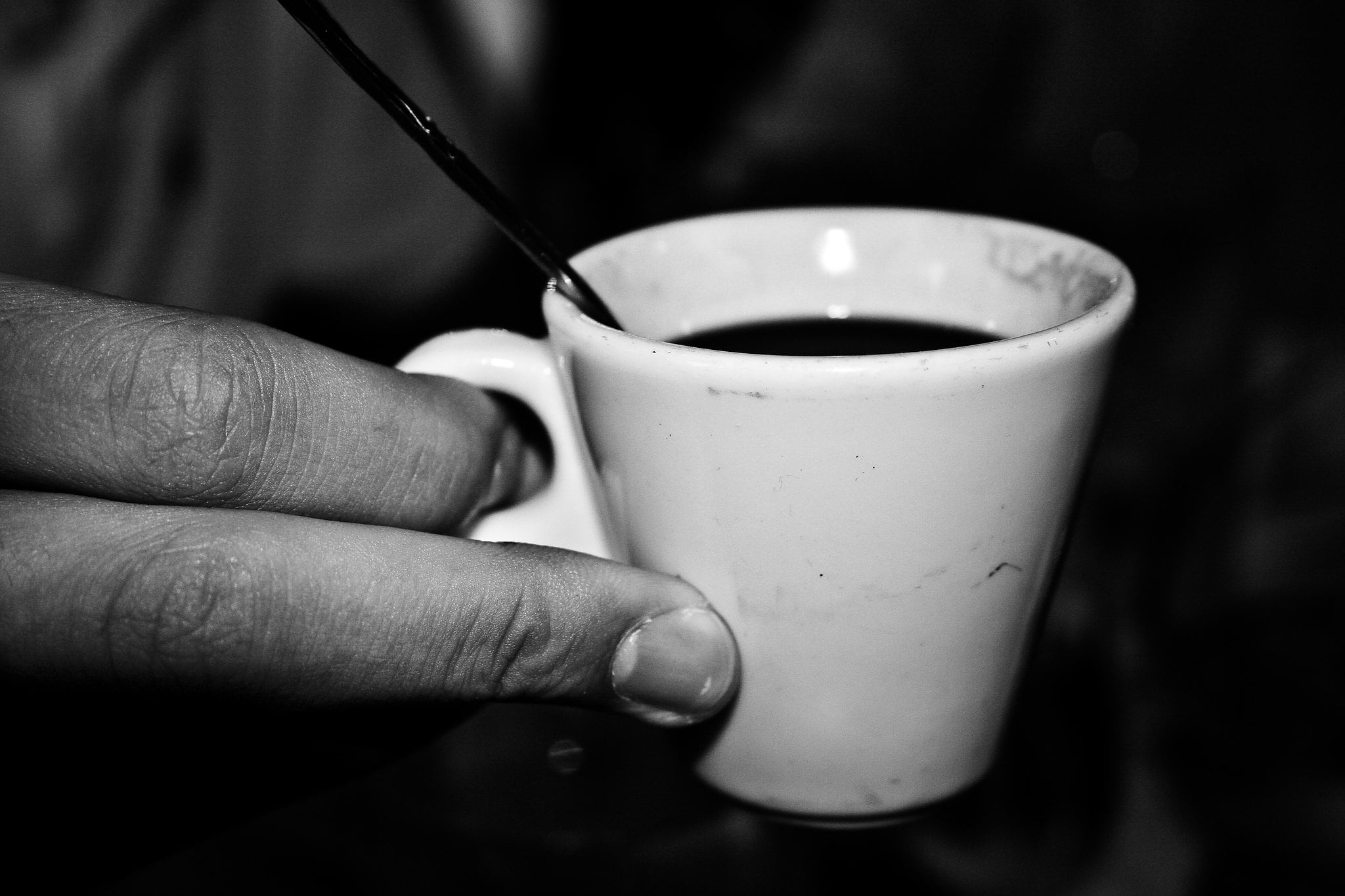
The Mediterranean lifestyle plays a vital role in cultural spaces, like festivals and celebrations, bringing together people of all ages, conditions and social classes.
Ospitalità: Italian Coffee rituals of hospitality
coffee is often drunk according to the rule of the 3 Cs –
caldo, comodo e in compagnia (hot, comfortable and in company)
The many merry moments of coffee
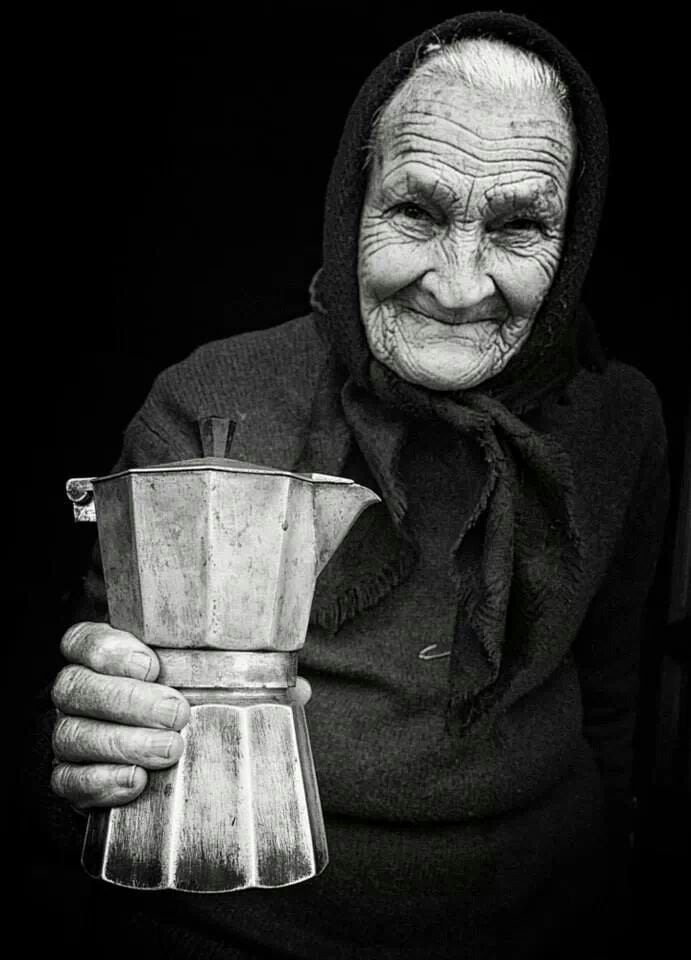
In every situation, from birth to grave in Italian households – Coffee would be there.
Unexpected guests – sure there is free coffee
A great Sunday meal – digestive coffee would be served,
Heartbroken – sip a comforting coffee with a shot of spirit (grappa),
A freshly married couple – get them a macchinetta (moka, napoletana or a home espresso machine with pods or capsule, or semi-professional espresso machines or other fancy coffee brewing devices, to their taste),
A baby is born – let’s celebrate with sweet coffee and a strengthening Tiramisù for the mamma,
Low blood pressure – drink a stimulating coffee or white wine in the morning,
Tired – have an energizing coffee,
A death in the family – lets bring food, wine and consolation coffee.
We are running late – ma prima un caffè – lets have a fast coffee first.
Tradition wants coffee, with sugar, to be the gift to bring to those who have suffered a mourning, as a sign of “consolation” for a not too bitter awakening in the morning. The coffeemaker in Italy is almost part of the family.
When I would visit home, I would open the fridge, sit down with a merenda, and my mother would look at me and lovingly say:
“You need some coffee, don’t you?”
“Yes, I’ve only had 5 today.”
Any problem we would wash down with coffee – my mother’s standard remedy for situations of stress and discomfort. Any hangover too is cured by it. But for that we would add some lemon and salt – my family’s secret home remedy for headache.
We are all coffee loves in Italy, isn’t it? If you ask my family, we are. And we invite friends for coffee obviously.
Let’s have coffee – that is a sentence and a ritual we live by.
Across cultures, offering coffee to guests is a gesture of hospitality and respect. Coffee rituals often involve elaborate preparation and serving methods, reflecting the care and consideration given to guests.
In Arab cultures, serving coffee symbolizes friendship and goodwill, while in Turkish tradition, it represents hospitality and acceptance. In South India kaapi is shared as a sign of hospitality and is considered an essential part of social gatherings and festivals. It symbolizes the age-old Indian tradition of treating guests as gods, signifying that their presence is valued and respected.
These coffee rituals embody the cultural values of warmth, community, and generosity.
In Italy also, the Moka or Napolititana, would always be there in the kitchens, on the stove, ready to gurgle when expected, and unexpected guests would come by, be it neighbors, friends or friends of friends. To offer guests something is good manners and bringing something when invited, also.
Coffee would be served, rich, strong, boiling hot, and comforting.
Storia di una caffettiera, by Riccardo Pazzaglia: … Then she added naturally: “In the morning I have a Napoletana made of only eight cups. She explained her the ritual.
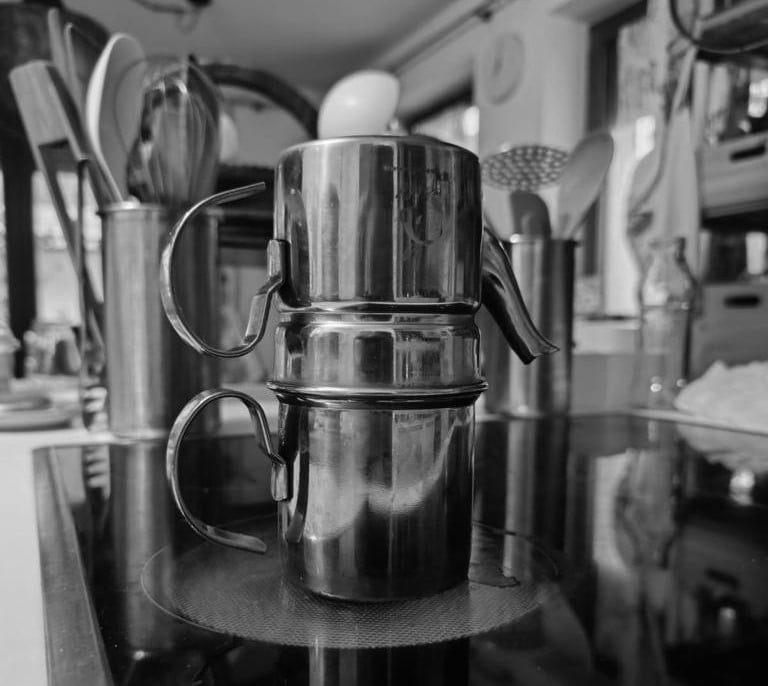
When I take the first cup, I don’t really feel it, it’s an opening cup.
Then I drink the second cup. This second cup I call “the warning cup”. In fact I sip it but only to advise myself: attention, the coffee is coming.
After that I forward the third cup, which has to prepare the body environment.
But it’s only the fourth cup that I “actually” begin to realize.
At the fifth I finally feel the taste.
The sixth is already the cup of whim.”
“And the other two?” Enzina asked, bewildered.
The other two are cups of consolation and encouragement, they mean: be careful, I am running out of coffee – She took Enzina’s hand and said:
“Enzina, I want to give you this coffee pot, so when you get married and have many children, you will make coffee for the whole family.”
“Have a coffee” is not a forced folkloric expression, but a loving reality to be proud of. It is rooted in ancient Greek-Latin hospitality traditions considered sacred, and the Mediterranean table culture.

The eyes knows — SEE
Sight is our fastest-acting sense. The shade of brown in our cup does correlate to the preparation method, greatly affecting the flavor, and aroma of the resulting coffee.
Well-made brewed or pour-over coffee should be lighter brown relative to moka, almost reddish.
French press and espresso done right occupy the other, darker end of the spectrum. Espresso actually sports two shades of brown: very dark liquid underneath, capped by the lighter crema on top — fine & dense in texture, it has discrete thickness, and a hazelnut brown color that covers the surface of the espresso in the cup.
The crema differs from the froth for the absence of bubbles. While the froth is considered a defect in the cup.
On an individual level, coffee preferences can be an integral part of one’s identity. Whether it’s the choice of a specific bean, roast, blending, brewing method, or the addition of milk and sugar, these coffee rituals often reflect personal tastes, memories, and experiences.
The Italian Caffè al BAR is served in diverse coffee vessels: like the little cup, the cappuccino cup, the tall glass, the small glass (bicchierino o bicerin) or the aperitif glass.
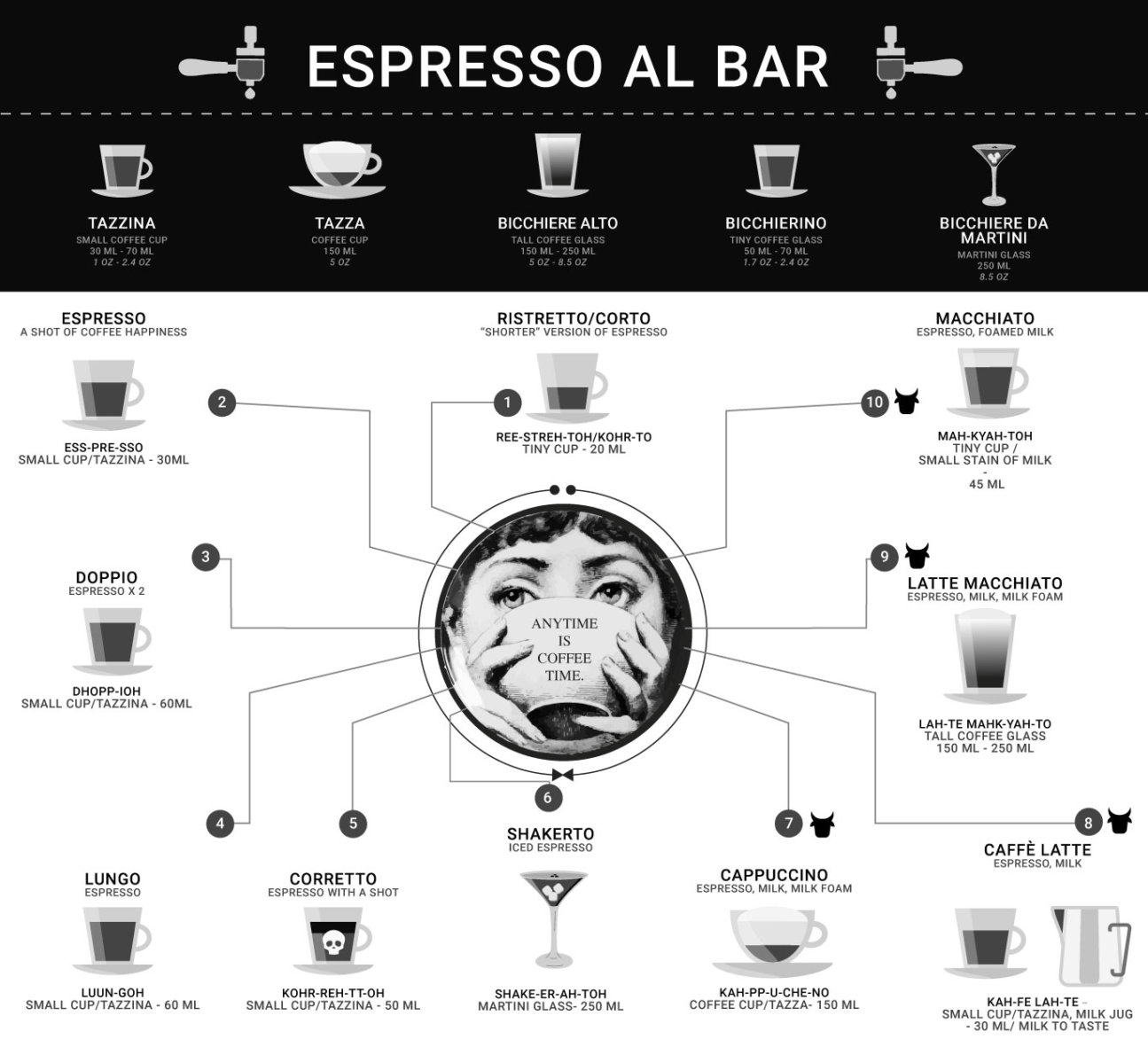
Italian regional Coffees
When it is time to order, the variations on coffee are as many and different as there are people in front of the counter: extra short, short, long, double, tall, small cup, large cup, glass, decaffeinated, hot Macchiato, cold Macchiato, lukewarm, with milk on the side, with soy milk, corrected, Moroccan, American, with cream, with fly, and so on and on and on…
While remaining a common ritual, coffee is deliciously diverse combined with regional flavours and Italian traditions from east to west and north to south along the Italian peninsula. Unique is, that every city and small town of the bel paese has their own local roaster, which is why espresso tastes different from region to region.
Despite the many preferences, one constant of Italian coffee does not change: the speed with which it is consumed. Espresso, must be express! It is prepared quickly and should be drunk just as quickly: in 3 sips, standing, at the bar!
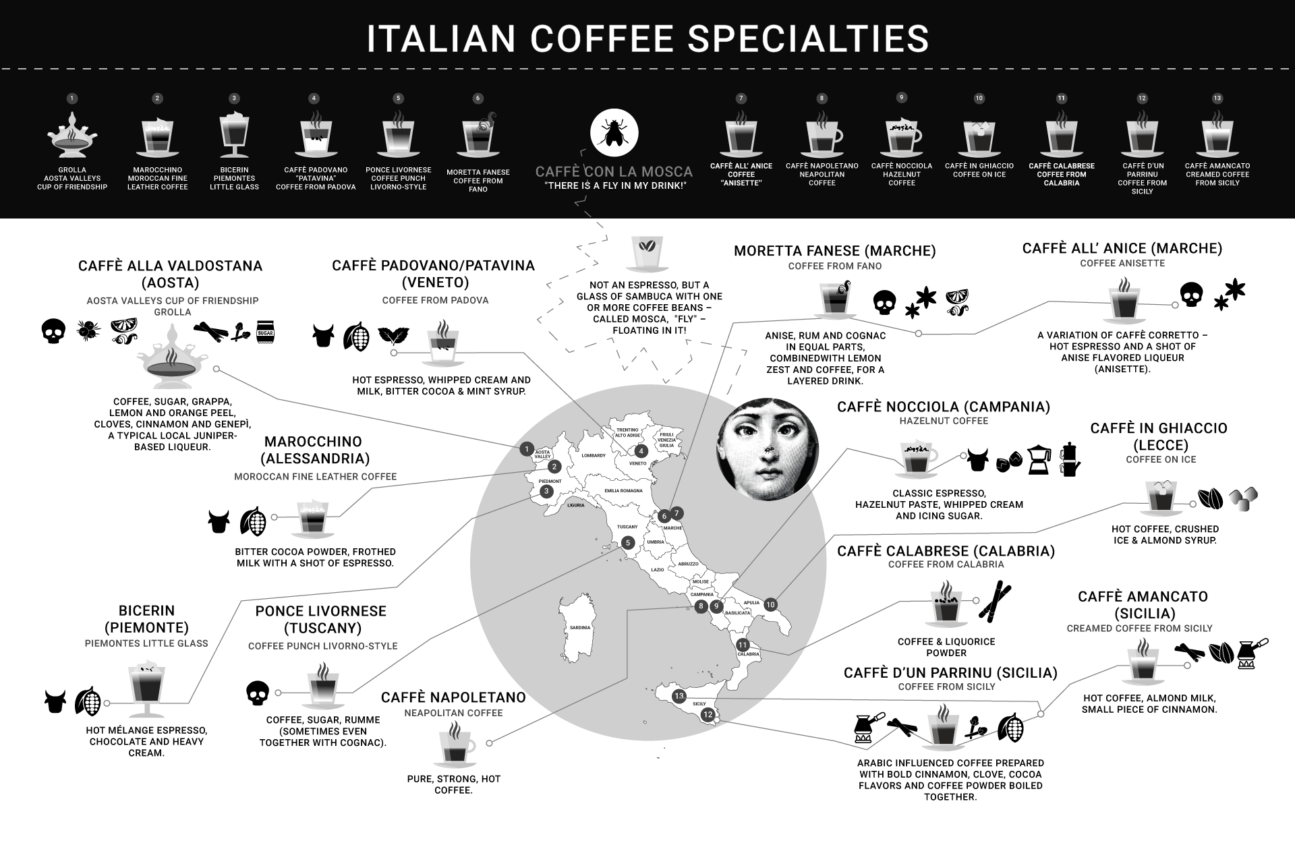

Regional coffee diversity in Italy knows many delicacies.
Italy the land of great Coffee . . .
Eduardo De Filippo in one of his best-known works “Natale in casa Cupiello” from 1931, turning to his wife Concetta, says about her lovingly prepared coffee:

Coffee is not for you. You don’t know how to make it and you don’t want to make it, because you want to save money. You don’t save money with coffee.
It is of poor quality: chisto fete ‘e scarrafune… literal, this coffee tastes like cockroach.

Totò, in the movie “Totò a colori” when, as a Capri guest, is offered a coffee, he blurts out “this café is nà ciofeca!”.
Ciofeca? Should derive from the Arabic “scìafek” (which is also very reminiscent of “crap”). The meaning could also describe something of low quality or, rightly so, a poor liquid. Undrinkable slop?
It takes a year for coffee to travel from field to cup, and a minute to mess it up.
Dario Ciarlantini
Bad coffee tastes
Hints of dirty, stagnant water happen, when the filter was not cleaned from the residues of the previous extraction or the water was not flushed from the group between an extraction and the ‘other. Defects or characteristics of the coffee production can give a medicinal, metallic, earth, wood or ash taste. Burned or over extracted Coffee tastes smoky and could remind you of a burnt wood. Terrible combinations such as wet earth or burnt and wet wood, cannot be mitigated even with two sachets of sugar and liters of milk.
When we visited a hacienda, in Colombias Eje caffetero, after telling the roast master that I am from Italy, he gave me a compassionate smile and told me:
“ Aha, you Italians finally stopped burning our coffee beans!”
Don’t allow yourself to be lulled into a sense of false security regarding all the wonderful coffee you get in Italy. There are some truly awful puddle waters out there. You could be the next victim.
Coffee, a symphony of sensory experiences
In a coffee you can find a symphony of aromas, a harmonious blend of the old and the new, tradition and innovation. As we embrace the aromas of an Italian coffee, we’re reminded that every demitasse, every bean, and every fragrance is a testament to the beauty of the sensory world we inhabit — a world enriched by the magic of aromas that have the power to transport us, awaken memories, and stir emotions. “Chocolaty, fruity and floral” describe the papillary sensations of a great cup of coffee. And the smell – Coffeichor, we love you – and caffeine we need you.
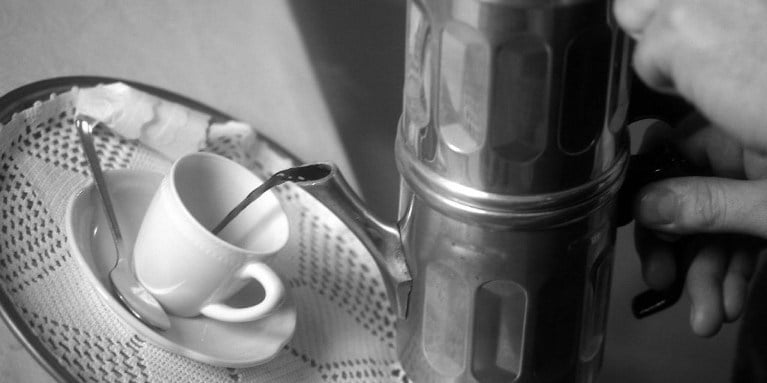
There is no limit to the number of coffee-making devices you can buy and the money you can spend on them. But it is possible to make excellent coffee at home with simple equipment, like a Napoletana or a Moka.
Call it whatever you like, Moka, Napoletana, coffee pot, coffee machine, cuccuma, cuccumella, jug, old wheelbarrow, but one thing is certain: it is essential for making Classic Italian coffee at home.
This historic Italian coffee makers remain timeless, because the “machinette – small machines” do not just make coffee: they make tradition, they make memories, they make perfume, they make music, they make us happy, they make us nostalgic, they make us feel like family even if we are somewhere else.
Celebrating the multi sensory magic of Coffee
The coffee experience is a multi sensory delight that engages all of our senses. From the alluring aroma of freshly ground beans to the soothing sounds of brewing, the comforting warmth of a coffee cup, and of the liquid ranging from pale brown to deep black, according to taste. Each element contributes to the overall enjoyment of coffee and the awakening of the senses — the celebration of Italian coffee culture, the love of food, family and friends…
Whether you’re a casual coffee drinker or a seasoned coffee connoisseur, the multisensory magic of coffee offers a moment of joy that can be savored each and every day, and in Italy even several times a day.
If love is in the air… it certainly smells like coffee.
Keep exploring:
~ ○ ~
Works Cited & Multimedia Sources
The history of coffee is an extraordinary study. If you would like to learn more about it, I heartily recommend the book, All About Coffee, by William Ukers. Written in 1928, it will delight you with detail.
- Allegra World Coffee Portal www.worldcoffeeportal.com
- Artusi Pellegrino. Science in the Kitchen and the Art of Eating Well, transl. Murtha Baca and Stephen Sartarelli. 2003.
- Biderman Bob. A people’s history of coffee and cafés. 2013.
- Café Culture Magazine www.cafeculturemagazine.co.uk
- Carosello Bialetti: la caffettiera diventa mito https://www.famigliacristiana.it/video/carosello-bialetti-moka-mito.aspx
- Cociancich Maurizio. Storia dell’ espresso nell’Italia e nel mondo. 100% Espresso Italiano. 2008.
- Comunicaffe International www.comunicaffe.com
- Davids Kenneth. Espresso Ultimate Coffee. 2001.
- De Crescenzo Luciano. Caffè sospeso. Saggezza quotidiana in piccoli sorsi. 2010.
- De Crescenzo. Luciano. Il caffè sospeso.
- Eco Umberto. “La Cuccuma maledetta” in Agostino Narizzano, Caffè: Altre cose semplici. 1989.
- Global Coffee Report www.gcrmag.com
- Gusman Alessandro. Antropologia dell’olfatto. 2004.
- Hippolyte Taine, wrote in, Italy: Florence and Venice, trans J. Durand. 1869.
- http://www.archiviograficaitaliana.com/project/322/illycaff
- http://www.baristo.university/userfiles/PDF/INEI-M60-ENG-Public-Regulation-EICH-v4-1.pdf
- http://www.coffeetasters.org/newsletter/en/index.php/category/a-baristas-life/
- http://www.coffeetasters.org/newsletter/it/index.php/il-galateo-del-caffe/01524/
- http://www.culturaacolori.it/fascismo-contro-le-parole-straniere/
- http://www.espressoitaliano.org/en/The-Certified-Italian-Espresso.html
- http://www.inei.coffee/en/Welcome.html
- https://archiviostorico.fondazionefiera.it/entita/585-bialetti-industrie
- https://bialettistory.com/
- https://cdn.intechopen.com/pdfs/55623.pdf Severini Carla. Derossi Antonio. Ricci Ilde. Fiore Anna Giuseppina. Caporizzi Rossella. How Much Caffeine in Coffee Cup? Effects of Processing Operations, Extraction Methods and Variables
- https://en.wikipedia.org/wiki/Drip_coffee#Cafeti%C3%A8re_du_Belloy
- https://en.wikipedia.org/wiki/ISSpresso
- https://en.wikipedia.org/wiki/Italian_meal_structure
- https://en.wikipedia.org/wiki/Neapolitan_flip_coffee_pot
- https://hal.science/hal-00618977/document
- https://hub.jhu.edu/magazine/2023/spring/jonathan-morris-coffee-expert/
- https://ineedcoffee.com/the-story-of-the-bialetti-moka-express/
- https://it.wikipedia.org/wiki/Caff%C3%A8
- https://it.wikipedia.org/wiki/Caff%C3%A8#Risvolti_etici_e_sociali
- https://it.wikipedia.org/wiki/Napoletana
- https://italofonia.info/la-politica-linguistica-del-fascismo-e-la-guerra-ai-barbarismi/
- https://italysegreta.com/italian-hospitality-the-invite/
- https://library.ucdavis.edu/wp-content/uploads/2022/06/LangPrize-2017-ElizabethChan-Project.pdf
- https://memoriediangelina.com/2009/08/11/italian-food-culture-a-primer/
- https://mostre.cab.unipd.it/marsili/en/130/the-everyday-eighteenth-century
- https://napoliparlando.altervista.org/cuccumella-la-caffettiera-napoletana/
- https://specialcoffeeitaly.com/barista-espresso-coffee-machine/
- https://specialcoffeeitaly.com/italian-breakfast-cappuccino-cornetto/?_gl=1*1gjfoya*_ga*OTE0MDM2ODM5LjE2OTMzNjE5OTg.*_ga_2HTE5ZB0JS*MTY5MzM2MTk5Ny4xLjEuMTY5MzM2Mjk0NS4wLjAuMA../
- https://specialcoffeeitaly.com/what-came-first-the-italian-bar-or-coffee/
- https://themokasound.com/
- https://uwyoextension.org/uwnutrition/newsletters/understanding-different-coffee-roasts/
- https://www.adir.unifi.it/rivista/1999/lenzi/cap2.htm
- https://www.bialetti.co.nz/blogs/making-great-coffee/using-bialetti-coffee-makers
- https://www.bialetti.com/ee_au/our-history?___store=ee_au&___from_store=ee_en
- https://www.bialetti.com/it_en/inspiration/post/ground-coffee-for-moka-should-never-be-pressed
- https://www.brepolsonline.net/doi/pdf/10.1484/J.FOOD.1.102222
- https://www.coffeeartproject.com/TheCollection/Amsterdam/2014.aspx
- https://www.coffeeartproject.com/TheCollection/Amsterdam/2014.aspx
- https://www.coffeeartproject.com/TheCollection/Milan/2013/Gallery/Other/Amalia-Chieco
- https://www.coffeeartproject.com/TheCollection/NewYork/2016.aspx
- https://www.coffeeartproject.com/TheCollection/NewYork/2017.aspx
- https://www.coffeeartproject.com/TheCollection/NewYork/2018.aspx
- https://www.coffeeartproject.com/TheCollection/NewYork/2019.aspx
- https://www.coffeeresearch.org/science/aromamain.htm
- https://www.coffeereview.com/coffee-reference/from-crop-to-cup/serving/milk-and-sugar/
- https://www.comitcaf.it/
- https://www.ecf-coffee.org/wp-content/uploads/2023/05/European-Coffee-Report-2022-2023.pdf
- https://www.espressoitalianotradizionale.it/
- https://www.euronews.com/culture/2022/02/15/the-italian-espresso-makes-a-bid-for-unesco-immortality
- https://www.faema.com/int-en/product/E61/A1352IILI999A/e61-legend
- https://www.finestresullarte.info/en/works-and-artists/the-bialetti-moka-the-ultimate-romantic-design-object
- https://www.finestresullarte.info/opere-e-artisti/moka-bialetti-oggetto-design-ultimi-romantici
- https://www.freemalaysiatoday.com/category/leisure/food/2022/02/15/italy-woos-unesco-with-magic-coffee-ritual/
- https://www.gaggia.com/legacy/
- https://www.gamberorossointernational.com/news/coffee-10-false-myths-to-dispel-on-the-beverage-most-loved-by-italians/
- https://www.gcrmag.com/calls-to-review-price-structure-of-italian-espresso/
- https://www.granaidellamemoria.it/index.php/it/archivi/caffe-espresso-italiano-tradizionale
- https://www.illy.com/en-us/coffee/coffee-preparation/how-to-make-moka-coffee
- https://www.illy.com/en-us/coffee/coffee-preparation/how-to-use-neapolitan-coffee-maker
- https://www.ilpost.it/2011/06/08/itabolario-bar-1897/
- https://www.itstuscany.com/en/bar-where-the-word-comes-from/“Cafe Hawelka”, John A. Irvin
- https://www.lastampa.it/verbano-cusio-ossola/2016/02/17/news/le-ceneri-di-renato-bialetti-nella-sua-moka-con-i-baffi-1.36565348/
- https://www.lavazza.com/en/coffee-secrets/neapolitan-coffee-maker
- https://www.lavazzausa.com/en/recipes-and-coffee-hacks/making-espresso-at-home
- https://www.linkedin.com/pulse/third-wave-coffee-meets-tradition-neapolitan-maker-bruno-lopez
- https://www.mumac.it/we-love-coffee-en/be-our-guest-en/progettazione-e-rito/?lang=en
- https://www.quartacaffe.com/images/pdf/carta-dei-valori.pdf
- https://www.repubblica.it/il-gusto/2021/07/26/news/caffe_il_piu_clamoroso_equivoco_gastronomico_d_italia-311835974/
- https://www.taccuinigastrosofici.it/ita/news/contemporanea/semiotica-alimentare/print/Pop-cibo-di-sostanza-e-circostanza.html
- https://www.thehistoryoflondon.co.uk/coffee-houses/
- https://www.wien.gv.at/english/culture-history/viennese-coffee-culture.html
- Illy Andrea. Viani Rinantonio. Furio Suggi Liverani. Espresso Coffee. The Science of Quality. 2005.
- Illy Andrea. Viani Rinantonio. Furio Suggi Liverani. Espresso Coffee. The Science of Quality. 2005.
- International Coffee Organization www.ico.org
- Kerr Gordon. A Short History of Coffee. 2021.
- La cremina per il caffè: come farla bene. https://www.lacucinaitaliana.it/news/cucina/come-fare-la-cremina-del-caffe/
- Lee Stewart Allen. Devil’s Cup. A History of the World According to Coffee. 1999.
- Leonetto Cappiello – Wikipedia page on the creator of the 1922 poster La Victoria Aduino.
- Markman Ellis. The Coffee House. A Cultural History. 2005.
- Mennell Stephen. All Manners of Food. Eating and Taste in England and France. 1996.
- Montanari Massimo. Il riposo della polpetta e altre storie intorno al cibo. 2011.
- Montanari Massimo. Il sugo della storia. 2018.
- Morris Jonathan. A Short History of Espresso in Italy and the World. Storia dell’espresso nell’Italia e nel mondo. In M. Cociancich. 100% Espresso Italiano. 2008.
- Morris Jonathan. Coffee: A Global History. 2019.
- Morris Jonathan. Making Italian Espresso, Making Espresso Italian.
- National Coffee Association www.ncausa.org
- Pazzaglia Riccardo. Odore di Caffe’. 1999.
- Pendergrast Mark. Uncommon Grounds. The History of Coffee and How It Transformed Our World. 2019.
- Perfect Daily Grind www.perfectdailygrind.com
- Scaffidi Abbate Mario. I gloriosi Caffè storici d’Italia. Fra storia, politica, arte, letteratura, costume, patriottismo e libertà. 2014.
- Schnapp Jeffrey. The Romance of Caffeine and Aluminum. Critical Inquiry. 2001.
- Sibal Vatika. Food: Identity of culture and religion. 2018.
- Specialty Coffee Association www.sca.coffee
- Spieler Marlena. A Taste of Naples. 2018.
- Tea and Coffee Trade Journal www.teaandcoffee.net
- The Long History of the Espresso Machine. www.smithsonianmag.com
- The Pleasures and Pains of Coffee by Honore de Balzac
- The relaxation ritual https://themokasound.com/
- Tucker, Catherine M. Coffee Culture: Local Experiences, Global Commensality, Society and Cuture 2011.
- World Coffee Research www.worldcoffeeresearch.org

